Posted in: Market Bounty
There are so many reasons to love winter squash – let us count the ways:
- Easy to prepare. Cut in half, scoop the seeds, and roast, bake, broil, saute, boil, or steam.
- They are nutrient powerhouses! Winter squash contain beneficial sources of fiber, B vitamins, Vitamin C, Vitamin A, potassium, manganese and antioxidants, specifically carotenoids, which have proven properties that help fight cancer, heart disease, and diabetes. Also wonderful for supporting your gut’s microbiome.
- A long storage life. Depending on the type, squash can last 2 to 6 months when stored at the ideal temperature of 50 – 60F degrees.
- Versatility. There are so many ways squash can be used. Roasted simply with EVOO and S&P to be featured in baked goods, soups, stews, dals, salads, and pickles.
- There are so many different varieties to choose from! Each kind has a unique shape, color, flavor, and best way to eat them.
The following are some of the winter squash varieties available locally (now in February), how to prepare them along with some recipes recommended by our staff and local community members:
But first, a few tips on general winter squash preparation…
- Always be sure to wash the exterior well before preparing/cooking.
- Cutting and peeling are two of the trickiest parts of preparing a large squash. Check out these methods to help make prep easier:
- First and most important, skip the peeling – the skin on many of these squash is edible. If the skin needs to be peeled, roast the squash and scoop out the flesh.
- Bake the squash for 10 minutes at 400F, then remove to cut and finish roasting.
- Microwave squash partially, for around 4 – 5 minutes, then cut into wedges and roast.
- Bake it whole for about 1 hour. Before cutting, prick squash a few times with a knife to let steam release. Then cut, remove seeds, scoop out flesh and proceed with the recipe.
Butternut
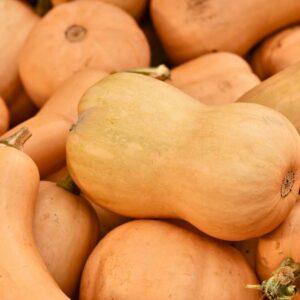
- About: It’s the ultimate all-purpose and sweetest of the winter squashes with a nutty taste similar to a pumpkin.
- Uses: Ideal for roasting and baking. Can be sautéed too!
- Recipes:
Delicata
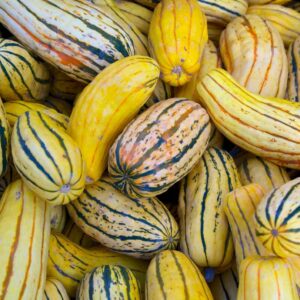
- About: This single-serving sized squash has a creamy flesh with a mild flavor comparable to sweet potatoes. The skin is edible, so don’t worry about peeling!
- Uses: Cut in half and bake it as is. Or cut into slices and broil, roast, or sauté. Great as a side dish, in a grain salad or as a pizza topping!
- Recipes
Green Kabocha
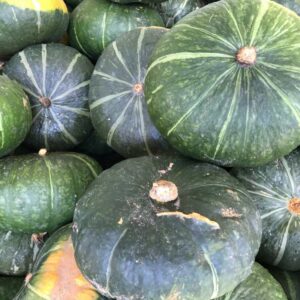
- About: Japanese for squash, the stout Green Kabocha has a nutty, earthy flavor. It tastes like a cross between a sweet potato and a pumpkin. The skin is edible.
- Uses: Cut into slices for roasted or steaming. Fantastic for mashing, curries, and soups.
- Recipes:
Tetsukabuto
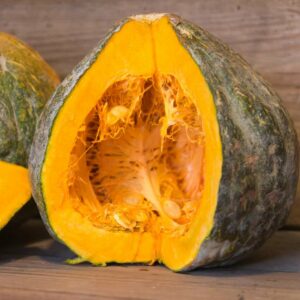
- About: Japanese for iron helmet, this hardy squash is a hybrid of Kabocha and Butternut and is known for its long term storage. The flesh is not quite as sweet as a butternut, but when roasted, its earthy flavor develops rich notes of hazelnut and browned butter.
- How to use it: Scrub the exterior clean, cut in half and scoop out the seeds. Then cut into slices for roasted or steaming.
- Recipes
- Squash and Miso Ramen
- Squash Snack Cake (PRO TIP: top it with cream cheese frosting)
Red Kabocha
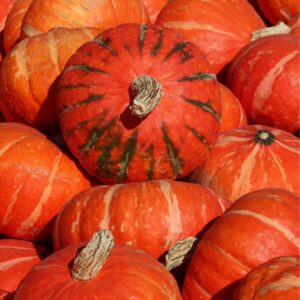
- About: It has the same shape and stripes as its its green counterpart. While the green kabocha is relatively savory, the red kabocha is unmistakably sweeter.
- Uses: Can be sliced and roasted. Suitable for baked goods, curries, and soups.
- Recipes:
Red Kuri
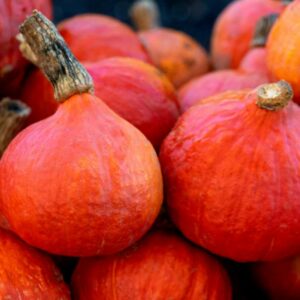
- About: Japanese for chestnut, this teardrop shaped squash has a smooth and tender texture with a sweet, buttery, savory flavor reminiscent of… you guessed it…chestnuts. The skin is edible – no need to peel!
- Uses: Delicious for soup, or dicing in a sauté or stir-fry. If you’re cooking a whole squash, be sure to pierce the skin in several places so steam can escape.
- Recipes:
Spaghetti
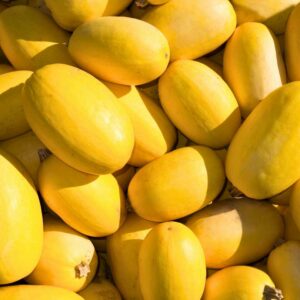
- About: When you cook the squash, the moist flesh develops strands that resemble spaghetti (hence the name). Tender, fragile texture, and a very mild flavor.
- Uses: Cut it in half lengthwise and scoop out the seeds. Bake or roast, then scrape out the strands. A terrific low-carb, gluten-free replacement for pasta – top with marinara, pesto, parmesan cheese, or mix in other veggies.
- Recipes
Recipes that use any kind of winter squash:
And don’t forget to save the squash seeds and toast them!
Hope to see you at PSU Farmers Market this Saturday with an tote full of winter squash!
